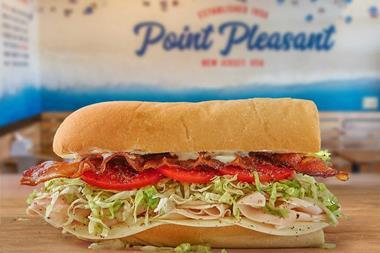With the opening of their Venetian restaurant in St James’s Market this month, Salt Yard Group’s Simon Mullins and Ben Tish continue their move into unfamiliar territory. Stefan Chomka reports
You can’t call it Lower Regent Street anymore,” says Simon Mullins of the unloved area just south of London’s Piccadilly Circus. “It’s now Regent Street St James’s, which sounds much more appealing.”
Mullins, founder of the Salt Yard Group, along with executive chef Ben Tish, has a vested interest in this subtle change. The pair are hoping that a new name, along with a makeover that has been carried out by landlord The Crown Estate over the past four years, will help create London’s latest dining destination. One that will see people make the journey from Soho and Mayfair to visit Veneta, the new Venetian restaurant that has just opened there this month.
Described by Mullins as having once been a “no man’s land with six lanes of buses to navigate”, the pavements around Lower Regent Street and Haymarket have been widened to encourage people to perambulate southwards from Piccadilly, buses have been re-routed and more restaurants and shops have been enticed, including destination fashion chain Dover Street Market. In addition, St James’s Market, a self-enclosed area of shops and restaurants with its own courtyard, has been created, and it is here that the operator of Spanish/Italian Soho restaurants Dehesa and Ember Yard, Salt Yard in Fitzrovia and Opera Tavern in Covent Garden, has chosen to launch its latest project.
Joining Veneta is Japanese ‘brasserie’ Anzu from the team behind ramen and sushi restaurants Tonkotsu and Tsuru; Aquavit, the two Michelin-starred Swedish restaurant that is crossing The Pond from New York; a more takeaway-led version on Samba Brands’ Duck & Waffle and Danish bakery Ole & Steen. “There’s an interesting tenant mix,” says Mullins. “In terms of us, Anzu and Duck & Waffle, it is welcoming new concepts. Novelty is the attraction here. It’s only a block south of Soho and there are now five good reasons to come down here. We are creating a dining destination.”
Going off the beaten track
Mullins knows only too well that a block in the wrong direction is the equivalent of being in a different postcode, but he is also aware of the benefits that being just off the main drag can bring. When Salt Yard Group opened Dehesa on Soho’s Ganton Street
in 2008, the area was a long way from becoming the restaurant hub it is today, but landlord Shaftesbury had spoken about its future plans and Mullins was convinced they would be a success. This same logic was applied when Opera Tavern opened a minute from central Covent Garden in 2011.
“We try to look at fringe areas,” say Mullins. “With Opera Tavern, we knew that Corbin and King were looking at putting in The Delauney and that Balthazar was going in and they would bring more people to the area. It’s a similar appraisal process for St James’s Market. There is always an element of risk with any new opening but there’s enough mitigating factors to make this a goer. It gives us a chance to explore something we’ve been thinking about.”
Indeed, Veneta has been on the cards for a long time. Mullins and Tish began talks with The Crown Estate more than four years ago and were committed to it even before they opened Ember Yard at the end of 2013. They subsequently fleshed out the concept for the Venetian restaurant on the train while going to look at a grill for their Soho site.
What is new territory for the pair is the building they have chosen. Mullins and Tish have traditionally taken existing sites, often with a bit of character to them – Opera Tavern is located in a former pub, Dehesa was a greasy spoon – but with Veneta they had a blank canvas with which to work. “We don’t normally go for new
builds but there are many upsides,” says Mullins. These include the fact that the front of the restaurant can be opened up onto the courtyard in the warmer months, not paying a premium and also having a rent-free period. “Fitting out a shell is
more attractive as you know what you are dealing with, as long as the services provided by the landlord are sufficient.”
There’s a certain bitter-sweetness to this last comment given that Veneta doesn’t have the electrical power Mullins and Tish initially required. The pair had wanted the entire restaurant to be induction but have had to compromise and also install gas burners to meet their cooking needs. It’s a similar story at the new Duck & Waffle, due to open after Veneta. The owners are believed to have wanted full induction, but have found the site’s combi-ovens alone use all the available electrical power.
Veneta is also Salt Yard Group’s biggest site to date. With 110 covers inside and a further 24 outside, it is bigger than Ember Yard by about a third. The site has a footprint of 2,500sq ft but, with the newly created mezzanine floor, the restaurant space has swelled to 3,000sq ft.
Constant search for the new
Mullins and Tish are unafraid of newness. Salt Yard Group has often been ahead of the curve in terms of trends, with many of its restaurants championing small plates beyond the Spanish theme before they became a thing in the UK. Ember Yard was one of the first restaurants to cook over solid fuel and the group’s restaurants’ riff on the Spanish/Italian theme is something that remains distinct to the capital.
In this sense, a focus on the Veneto region of Italy, and Venice in particular, is a departure. “It’s been an exciting creative process for us and the team to be able to do new stuff,” says Tish. “The sites lead the concepts a lot. The space wouldn’t work with any of our existing ones so we knew it had to be something different.”
Focusing on the cuisine of Venice allows the pair to explore different foods without being too niche. While it still operates in the bustling Italian sector, Veneta’s point of difference is that it is honed on one particular region of Italy, one that has largely been ignored by chefs in the UK. “The Italian market is quite crowded and is getting more so,” says Tish. “Margot [the newly opened restaurant in Covent Garden] is Italian, and The Clove Club will also be doing that cuisine when it opens Luca, but they are both quite broad. We are being more specific.”
Thanks to the likes of Russell Norman’s Polpo restaurant group and Cicchetti, the all-day Italian concept from San Carlo Group, consumers are already familiar with cicchetti, a staple of the Venetian dining scene. Veneta will not limit itself to cicchetti – the small plates will only have a minor role on the menu – but instead explore dishes from across the Veneto region.
“It’s a full take on Venetian food. There is more to it than cicchetti, it will have a small cichetti section but it goes much deeper than that. Fish is a huge thing in Venice, which is quite unusual in northern Italy, and this will be reflected on the menu,” says Tish, who has installed an – albeit small – raw bar in the restaurant. As well as the more common species, the menu will feature seafood such as moeche, soft shelled crabs from Venice that are only available a couple of times a year, whole grilled octopus and red prawns as well as different types of crudo.
Many of Veneta’s dishes will also have a Byzantine feel in reference to Venice’s location on the spice route, with ingredients such as dates, almonds, saffron and cumin. The restaurant will also give a Venetian twist to other dishes, such as its sharing steak plate (the meat is sourced from Yorkshire, not Italy) served with a marsala sauce made with girolles and accompanied by rosemary and garlic sautéed potatoes. “It will be a brasserie-style menu with small plates and large sharing dishes,” says Tish. “There will more dishes on the menu than at the other sites but not massively so. Big brasserie menus tend not to change much, we want to be able to change it fairly regularly.”
Veneta also sees Salt Yard Group enter into all-day dining for the first time. While it already served a weekend brunch at some sites, Veneta will open every day from 7am. Breakfast dishes will combine traditional Venetian foods such as frittelle – doughnuts that will come filled with jam, chocolate or saffron creme patissiere – with slants on more recognisable options. Eggs Benedict will be made with a polenta brioche muffin and served with a poached egg, smoked eel and saffron hollandaise, for example.
Pricing will be keen, with Mullins insisting that Veneta will not come with a typical St James’s price tag to avoid alienating his existing customers. Higher ticket items such as T-bone steak and whole fish will be on offer but average spend is anticipated to be £30-£35, taking into account a lower spend at breakfast. This is in line with the group as a whole, where spend is between £28 and £35 a head (Ember Yard is £40 because it has more of a cocktail focus).
Building the brands
Whether Veneta will be the pair’s last new concept remains to be seen. Their reluctance to recreate existing restaurants has led to a multifaceted group they admit is less simple – although more fun – to operate than just one or two core brands. While there are synergies across the group – Tish works with suppliers to lock down the supply of ingredients at a certain price that are then used differently at each site – Mullins does not yet want to be regarded as a chain. “So far, growth has been pretty organic,” he says. “We’ll never say we won’t be a chain but we’ll never say we will be one either. We are not going to limit ourselves to the concepts we have – we’ll always keep our options open.”
Yet, they won’t hesitate to capitalise on the strong brands they have created should sites come up. The group is taking a space at the redeveloped BBC Television Centre in Shepherd’s Bush, in which it will open a second Salt Yard, with new elements. “We know [Salt Yard] is tried and tested, and what we can do with it,” says Mullins. “The Opera Tavern format could also work in another pub and Ember Yard could work elsewhere too.” Maybe the Tuscan/Catalonian concept will have to wait.

































